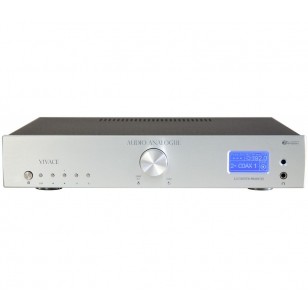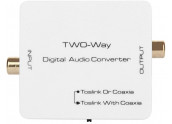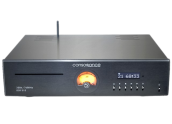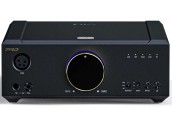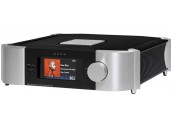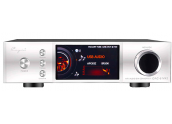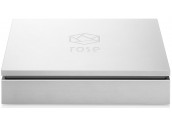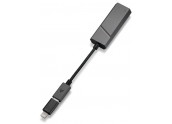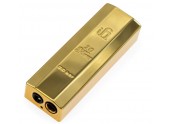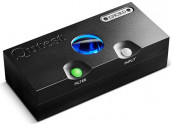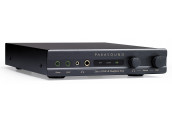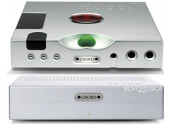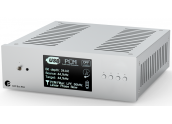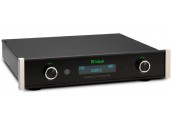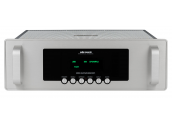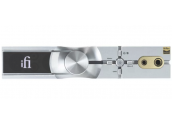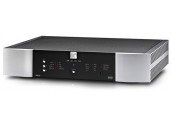Audio Analogue Vivace AirTech DAC / Previo
Audio Analogue Vivace AirTech
The Audio Analogue VIVACE DAC/Preamplifier is a high performance DA converter that combines the highest digital audio technologies with an innovative zero feedback analog output stage. It is also provided with a volume controlled preamplifier unbalanced output to directly drive a power amplifier. Several inputs are furnished to interface many different audio systems and the digital chain is highly settable by the user. Because of its characteristics the Audio Analogue VIVACE D/A Converter-Preamplifier is the perfect joining link between your digital audio sources and your analoueg world.
Main Features:
Output stage: As always for the Audio Analogue products including a Digital to Analog section the output stages is the part where more experimentation is performed. As first let's see what is usually done. The best DACs (Integrated Circuit) have a current output type. Therefore a two stage architecture is usually implemented. The first is a current to voltage made by an operational amplifier while the second is a stage performing the voltage gain and filtering. The second stage is made with a circuit based on an operational amplifier or on a discrete components circuits. Both the strategies often (almost always) use feedback technique. What Audio Analogue have realized is a single circuit, all made by discrete components, which performs all the above functions in a zero feedback topology. Is not Audio Analogue's intention entering the debate sometimes coming out in the audio field about the goodness of the feedback technique. Audio Analogue's goal is instead to find new circuits which could give different sound qualities. So they have decided to completely reinvent the output stage approach. In fact as it is said: "if you always walk on the same streets you will always arrive in the same places". What Audio Analogue have found is a different sound which has been defined as much more "natural" by the listeners in the tests they have performed.
USBDAC Section: Because of the increasing importance of music reproduced by a USB connection, Audio Analogue have developed a technology to play such files both in adaptive and asynchronous mode. The accepted input sample frequency reaches the 192KHz for a 24bits file stream. The USB data stream is converted in a SPDIF signal that is passed to the Digital to analoueg conversion section via a galvanic isolated connection.
Digital Input Selection and SRC (Sample Rate Converter): Audio Analogue use a single component to select the digital input, receive the signal and change the signal sample rate. Usually there is a SPDIF receiver selecting the digital signal and extracting the data from the SPDIF selected signal and then a further component, the sample rate converter IC, which works on the extracted signal changing the sample rate. To have a single component making all the tasks is very important because avoid adding jitter in the communication between the otherwise two components.
Clock sources and settable output sample frequency: It is known that increasing the signal sample rate not always improves the audio quality. In fact it seems commonly accepted between the audiophiles that to increase the audio performances the output signal sample rate has to be an integer multiple of the input sample rate or to be the same of the input sample frequency. Some others suggest instead that for each digital to analogue converter there is an optimum output sample frequency. Anyway because the common sample rates are integer multiples of two different basic frequency, that's say: 48KHz and 44.1KHz, to have the best performances requires having two different clock sources. Such fact is often neglected in DA converters. Instead Audio Analogue have designed two very clean and jitter free clock oscillators to supply the clock to the Sample Rate Converter and DAC. Of the two, just one oscillator is active according to the output sample frequency. Also Audio Analogue permits the user a complete control on the output sample rate frequency. In fact Audio Analogue allow you to change the output sample frequency to find its best set up according to three different output sample frequency selection criterion: Direct, Automatic, Custom.
DAC Section: Audio Analogue use the Texas Instruments 32-bit, 200KHz Sampling, Advanced Segment, Audio Stereo DAC: PCM1795. That is a very performing digital to analogue converter with a current output.
Phone Output: using headphones to listen music is becoming more and more popular. This to have a different listening experience or to don't disturb other people around. Therefore a Phone output, which input is taken directly buffering the output stage, has been implemented.
Trigger Output: As for all the Audio Analogue last generation products a DC 12V Trigger output is supported. In such way the user can turn on all the stereo system having just one unit working in stand by, therefore decreasing the standby power consumption of the chain.
Power supply: a toroidal transformer is used with secondary stages dedicated to each part. The analog power supply has been realized using all of Audio Analogue‘s strategies to reduce any interference and kill even the smallest of noise from all of its components. Regulation stages have been placed in every sensible circuit point and the bypass capacitors have been chosen not only for their electric performance but also after long and careful listening sessions
16 productos de la misma categoría:
-
ROCO C-022
ROCO C022 - Conversor Digital - Digital | De Digital Optico a Digital Coaxial - Tamb...
45 € -
Opera Consonance CDS120
Opera Consonance CDS120 lector CD, Streamer y DAC | Entradas digitales: USB2.0, USB,...
2.100 € -
FiiO K9 Pro ESS
FiiO K9 Pro ESS - Conecta tus auriculares, tus altavoces activos domésticos, tus dis...
849 € 729 € -
Moon 891 - North Collection
Moon 891 - North Collection- PRÓXIMAMENTE - Previo estéreo de referencia con DAC y ...
28.500 € -
Cayin iDAC 6 MK2
Cayin iDAC 6 MK2 segunda generación del iDAC con chip mejorado y más conexiones | DA...
1.350 € 995 € -
HiFi Rose RSA720
HiFi Rose RSA720 - Ladrón de USB con filtro de ruidos eléctricos y vibraciones para ...
529 € -
Astell Kern AK HC2 (PEE52)
Astell Kern AK HC2 - Amplificador / DAC de auriculares | USB-C y se incluye el adapt...
219 € 149 € -
iFi GO Bar Gold
iFi GO Bar GOLD - Edición Limitada a 1.000 unidades - Amplificador / DAC de auricula...
499 € -
Chord Qutest
Chord Qutest DAC - Conversor Digital Analógico basado en el Chord Hugo 2 (2.249 €) p...
1.495 € -
Parasound ZDAC V2 Tienda
Oferta de escaparate en color NEGRO - Parasound ZDAC V2 - Conversor Digital Analógic...
848 € 399 € -
Chord Hugo TT2 + TToby
Conjunto formado por Hugo TT2 + Etapa potencia TToby de 100 Watios - DAC / Previo es...
8.890 € -
Project DAC BOX RS2
Project DAC BOX RS2 - Conversor Digital Analogico | Doble conversor (uno por canal) ...
2.099 € -
McIntosh MDA200
McIntosh MDA200 - Conversor Digital Analogico - Rendimiento digital de primera calid...
5.999 € -
Audio Research DAC9
DAC 9 Procesador digital de audio de referencia | Tecnología híbrida válvulas de vac...
11.990 € -
IFi Neo iDSD 2
IFi Neo iDSD 2 DAC, preamplificador y amplificador de auriculares | Bluetooth HD 5.4...
899 € -
Moon Neo 280D Mind2
Moon - Versión del DAC280D con el módulos MIND2 INTEGRADO -> DAC y Streamer en un...
3.900 €

